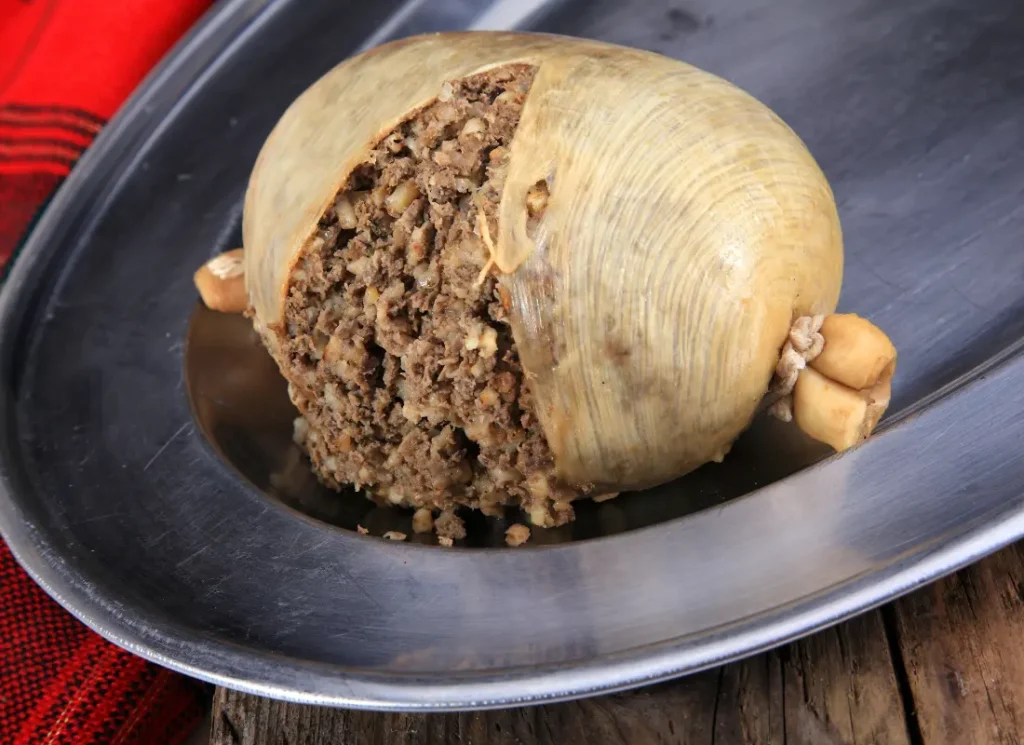Origin: Scotland
Type: Main course
Main Flavours: Rich, spicy
About Haggis
Haggis is a Scottish dish. It is traditionally made with the organs of a lamb (a mixture of sheep’s heart, liver, and lungs), but it is more commonly made now with more modern cuts of meat, or even vegetarian. The main meat or meat replacement is combined with oatmeal, onions, suet, and a blend of spices. This savoury mixture is traditionally encased in the sheep’s stomach (but, again, modern versions use an artificial replacement), then gently boiled until tender. Haggis is most commonly made for festive occasions in Scotland such as Burns Night, accompanied by neeps and tatties.
What Zsófi Says About Haggis
It all started in the 18th century and the economic decline that it brought to the country. While England’s economy was booming in the 1700s with the Agricultural Revolution which made all kinds of produce more readily available to the masses, Scotland was struggling. Haggis is cheap, easy to store, and guarantees that none of the parts of the animal are wasted. It became a sort of gastronomical panacea for the people.
Haggis soon drew a sharp demarcation line between the two countries: while its consumption was booming in Scotland, almost nobody was eating haggis in England. This difference was picked up on and enlarged by the hostile politics between the two countries in which England depicted haggis and other Scottish dishes as uncivilised to which the Scottish responded with growing pride over their cuisine. Haggis became cemented as the Scottish National Symbol in 1786 when another Scottish National Symbol, Robert Burns wrote one of his most famous poems: The Address to Haggis.
No matter the origin, haggis is as Scottish as they come. It is an absolute must-try – especially if you’re lucky enough to be there on Burns’ Night.
Now, for those for whom offal and sheep’s stomachs are not too appetising (I’m one of you guys), there are of course many many vegan versions available. Scotland is one of the best countries for vegan/vegetarian food options, and this is not wasted on haggis. Vegetarian haggis became popular as early as the 1980s, and have since developed many different recipes to try. The best recipes for me are the ones that keep all the ingredients and seasonings of the original, just replace all the animal organ stuff. So if you see any with oats, and split peas, nutmeg and mace, you’re golden. One of my favourite recipes includes portobello mushrooms too which gives a meaty texture, mixed with lentils and oats, and I highly suggest you give it a try.
Fun fact: Haggis is prohibited in the USA. There is a law against importing food that includes sheep’s stomach so American readers, get those flight tickets to Scotland now!
Read Zsófi’s full article “A Beginners Guide to Scottish Food” here!
Haggis Recipe
Haggis Ingredients
1kg of lamb meat (traditionally offal, aka lambs organs, which you may be able to source from your local butcher, or you can use lamb mince)
250g oatmeal
2 onions, diced
1 tsp dried coriander
1 tsp nutmeg
1 tsp salt
1 tsp black pepper
Artificial sausage casing, or small loaf tins if you can’t find any
Haggis Instructions
If you’re using offal, this is traditionally boiled or cooked in a pressure cooker, but this step isn’t necessary if you’re using lamb mince.
You can also gently fry the onions and spices before adding it to the rest of the haggis mixture for a richer taste, but traditionally they are added to the mixture raw.
Mix all of the ingredients together in a bowl.
Whilst traditional haggis was made with the sheep’s stomach, all haggis is now made with artificial sausage casing. This is the only way to make true haggis, but it can be hard to get hold of. So, if you have sausage casing, spoon in the mixture, seal it tightly, then boil for several hours until the haggis is cooked through. If you don’t have sausage casing, you can put it into loaf tins or a casserole dish, cover, and bake it in the oven. (The cooking time will depend on how big your tins are!).
Serve with neeps and tatties!

